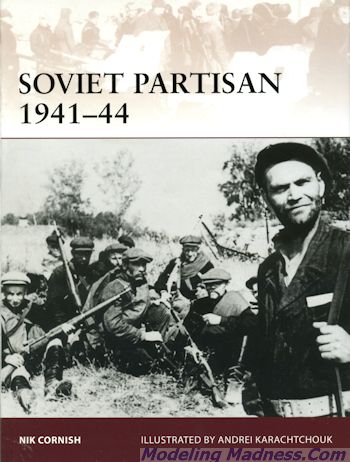 During
an invasion, there is almost always a group of people who will fight the
invaders. These folks go by a variety of names from freedom fighters to
terrorists to a fifth column, and to the underground. During WWII some of these
folks were called partisans and could be found in many nations that had been
overrun by the German Army.
During
an invasion, there is almost always a group of people who will fight the
invaders. These folks go by a variety of names from freedom fighters to
terrorists to a fifth column, and to the underground. During WWII some of these
folks were called partisans and could be found in many nations that had been
overrun by the German Army.
Most of us in the west are familiar with the French underground and
their work impeding the Germans at every opportunity. Over on the eastern front,
these people were called partisans and you could find them in the "temporarily
occupied territories" of the Soviet Union as well as in Greece and Yugoslavia.
All of these groups had things in common. They were often civilians, they were
generally supported by outside areas, and as the war progressed, the reprisals
taken by the Germans against the local populations grew more and more
oppressive.
From the beginning, those operating in the Soviet Union were supplied
as best they could by the Red Army. These units were organized the same as
regular army units and those chosen to operate behind the lines were very
carefully chosen. Life as a partisan was even more difficult than that of the
regular Army soldier. They had to be able to think somewhat independently, had
to be able to live off the land, and had to be able to be ready to move at a
moments notice.
These men were not equipped to fight major battles. While some units
had a few pieces of artillery, these sorts of weapons were not conducive to
groups that want to 'melt into the forests and swamps' as was the norm for
partisans. Mostly these groups destroyed bridges, rail lines, and ambushed
supply columns. While they were not a decisive part of the Patriotic War, their
exploits gained propaganda value far beyond their accomplishments and were a
major morale boost back home. They also required the Germans to use troops to
defend against them that could be used at the front lines.
In this book, the author provides us a background to the purpose of
the partisans, how these men were recruited, the way
they were trained, and the sorts of
weapons and uniforms they wore. Also as a standard part of this series, we see
what it was like to be on campaign, how they got along with each other and how
well they fought. Though there were few set battles, one is chosen to show how
these units performed in this sort of uncommon situation.
In all, it makes for a very interesting read about a subject that
often fires the imagination but about which few really know. It also is a book
that does not simply repeat the usual overblown propaganda that has been the
norm of previous books on the subject. A book I can easily recommend to you.
September 2014
For more on the complete line of Osprey books,
visit http://ospreygrp.com
or contact them at Osprey Direct, PO Box 140, Wellingborough, Northants,
NN8 2FA, UK. In the US, it is
Osprey Direct at 443 Park Avenue South, New York, NY 10016, where you can
get a catalogue of available books.
If you would like your product reviewed fairly and quickly, please
contact
me or see other details in the Note to
Contributors.
 During
an invasion, there is almost always a group of people who will fight the
invaders. These folks go by a variety of names from freedom fighters to
terrorists to a fifth column, and to the underground. During WWII some of these
folks were called partisans and could be found in many nations that had been
overrun by the German Army.
During
an invasion, there is almost always a group of people who will fight the
invaders. These folks go by a variety of names from freedom fighters to
terrorists to a fifth column, and to the underground. During WWII some of these
folks were called partisans and could be found in many nations that had been
overrun by the German Army.